1.1 Introduction
Parts II and III of this document explain the capabilities and contribution of more than 150 satellites planned by space agencies around the world over the next 15 years. The majority of these are dedicated to the study of different aspects of the Earth System, and in particular climate change science.
The planning and funding of these missions is the responsibility of individual governments, based on their strategic assessments of national priorities and user community needs.
Through the Committee on Earth Observation Satellites (CEOS), member agencies respond to the necessity for international cooperation and harmonisation in future efforts, driven by a need for a common understanding of the state of our environment and future information priorities. Coordination through CEOS is particularly important given the lead times involved in planning and launching Earth observation satellite missions and the need for timely information to anticipate the most pressing environmental issues that will face future generations. This section presents a brief discussion of the context for these efforts, including:
- a discussion of humankind’s impact on the Earth System and the consequent global changes (in part based upon the IGBP Science Report: ‘Global Change and the Earth System: A planet under pressure’ (2001));
- scientific predictions for the future, based on climatic trends, and estimates of human population growth and consumption patterns (in part based upon the Third Assessment Report of the Intergovernmental Panel on Climate Change (IPCC), ‘Climate Change 2001’);
- the beginnings of global environmental governance: the importance of Earth System science for the development of our understanding of global change and mitigation of its effects, and the necessity for observations of the Earth as baseline information for future decision-making aimed at sustainable development (in part based on ‘A Guide to World Resources 2002-2004’ by UNDP, UNEP, World Bank, and the World Resources Institute).
1.2 Humankind’s interaction with nature
Not so long ago, our planet Earth seemed infinitely large in its extent and capacity to support human life and lifestyles. Distances seemed huge, news travelled slowly, and our imaginations were fired by rare images of exotic peoples and unspoilt and remote countries – abundant in natural beauty and resources. In 2005, the Earth feels like a much smaller place. Modern communications and transportation have shrunk distances, the daily news is a global bulletin, and we communicate with, and consume and trade products and services supplied by, people and countries from around the globe – without so much as a second thought.
Until very recently in the history of Earth, humans and their activities have been an insignificant force in the dynamics of the Earth System. From the start of the industrial revolution more than 200 years ago, developed nations have achieved ever greater prosperity and higher living standards. Combined with a six-fold increase in the global human population within those 200 years, these factors have resulted in significantly increased resource consumption, evident in agriculture and food production, industrial development, energy use and urbanisation.
Some facts are slow to be absorbed and accepted by a generation unaccustomed to associating environmental factors with lifestyle and consumer choices. But today it is a reality that humankind has begun to match and even exceed nature in terms of changing the biosphere and impacting other facets of Earth System functioning.
The magnitude, spatial scale, and pace of human-induced changes to our atmosphere, oceans, geology, chemistry, and biodiversity are unprecedented and are so pervasive and profound that they affect the Earth on a global scale in complex, interactive and accelerating ways. We now have the capacity to alter the Earth System in ways that threaten the very processes and components upon which humans depend – not simply requiring some adjustments in society, but so far-reaching in impact that human existence may be radically and irreversibly altered.
The speed of these changes is in the order of decades to centuries, not the centuries-to-millenia pace of comparable change in the natural dynamics of the Earth System. In other words, changes that normally happen in geologic time are happening during the lifetime of a human being:
- in a few generations humankind is in the process of exhausting fossil fuel reserves that were generated over several hundred million years;
- human action has transformed almost half of the Earth’s land surface with significant consequences for biodiversity and climate;
- more than half of all accessible freshwater is used directly or indirectly by humankind;
- concentrations of several climatically important greenhouse gases, in addition to CO2 and CH4, have substantially increased in the atmosphere;
- coastal and marine habitats are being dramatically altered; 50% of mangroves have been removed and wetlands have shrunk by one-half;
- extinction rates are increasing sharply in marine and terrestrial ecosystems around the world;
- the Earth is now in the midst of its first great extinction event caused by the activities of a single biological species (humankind).
In 2002, a report on the state of world resources (published by the UN Development and Environment Programmes, World Bank, and World Resources Institute) indicated an ‘overwhelming human dependence on rapidly deteriorating ecosystems’ – the systems that support all life on Earth.
In brief, the ways in which we meet basic human needs (such as water, food, shelter, health, employment) of the 6.4 billion people inhabiting the Earth at present, have a critical impact on our environment – at all scales. In particular, the affluence of the developed world and our appetite for consumer goods for entertainment, for mobility, for communication and a broad range of goods and services, is placing significant demands on global resources.
| Our Dependence and Impact on Ecosystems |
| Annual value of global agricultural production |
$1.3 trillion |
| Percentage of global agricultural lands showing soil degradation |
65% |
| Population directly dependent on forests for survival |
350 million |
| Decline in global forest cover since pre-agricultural times |
50% |
| Population dependent primarily on fish for protein |
1 billion |
| Percentage of global fisheries over-fished or
fished at their biological limit |
75% |
| Percentage of world population living in
water-stressed river basins |
41% |
| Percentage of normal global river flow extracted for human use |
20% |
| Percentage of major river basins strongly or moderately fragmented by dams |
60% |
| Percentage of Earth’s total biological productivity diverted to human use |
40–50% |
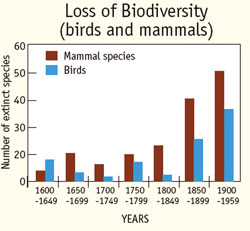
1.3 The Earth’s Signs
There is increasing evidence to suggest that the functioning of the Earth System is changing in response to human activities. This ‘global change’ includes, but is not limited to, climate change.
In 1988, the Intergovernmental Panel on Climate Change (IPCC) was established to bring together the world’s leading scientists to conduct rigorous surveys of the latest technical and scientific literature on climate change. The IPCC summarised the main effects of human activity on our climate as follows:
- the composition of the atmosphere has changed since the industrial era, with increased concentrations of greenhouse gases due primarily to fossil-fuel burning and land-use change: since 1750, concentrations of carbon dioxide have increased by 31%, methane by 151% and nitrous oxide by 17%; it is believed that present carbon dioxide concentrations are unprecedented in the past 420,000 years;
- land and oceans have warmed: global average surface temperature has increased by about 0.6°C during the 20th century;
- globally, it is very likely that the 1990s were warmer than at any time in the last 1000 years;
- precipitation patterns have changed;
- the frequency, persistence and magnitude of El Niño events has increased;
- global average sea level has risen over the last century: tide gauge data indicate a global average rise of 10-20cm, attributed to thermal expansion of the oceans and melting of the polar ice caps and glaciers.
The Earth's climate does vary naturally as a result of interactions between the ocean and the atmosphere, changes in the Earth's orbit, fluctuations in energy received from the sun and volcanic eruptions. However, the best scientific knowledge and evidence available suggests that the Earth System has recently moved well outside the range of natural variability exhibited over at least the last half million years. The nature of changes now occurring simultaneously in the global environment, their magnitudes and rates, are unprecedented in human history, and probably in the history of the planet.
The main human influence on global climate is likely to be emissions of greenhouse gases such as carbon dioxide (CO2) and methane. At present, about 6.5 billion tonnes of CO2 are emitted globally each year, mostly through burning coal, oil and gas for energy. Changes in land use mean a further net annual emission of 1-2 billion tonnes of CO2. Increasing concentrations of these greenhouse gases in the atmosphere over the last 200 years have trapped more energy in the lower atmosphere, altering global climate.
The IPCC’s 2001 Third Assessment Report on the scientific basis for climate change reported that “an increasing body of observations gives a collective picture of a warming world and other changes in the climate system”. The report concludes that “there is new and stronger evidence that most of the warming observed over the last 50 years is attributable to human activities”.
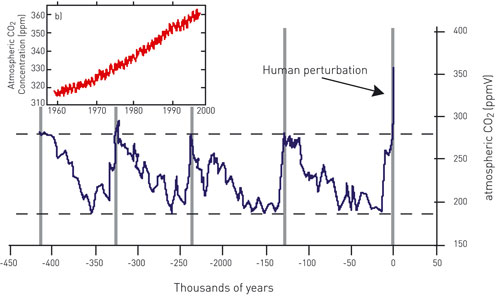
Recent human influence on the carbon cycle
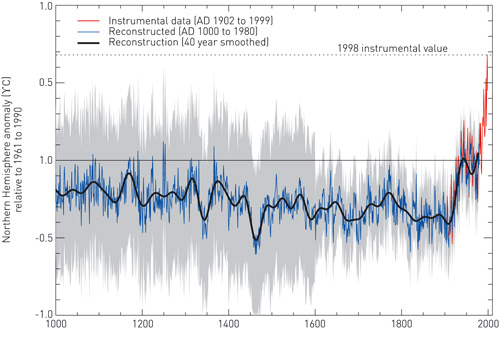
Variations in Earth’s surface temperature for the past 1000 years
1.4 Future Trends
In the summer of 2003, an extreme drought and heat wave hit Europe. This had enormous adverse social, economic and environmental effects, such as the premature deaths of up to 30,000 vulnerable people (particularly the elderly), the destruction of large areas of forests by fire, and effects on water ecosystems and glaciers. It caused power cuts, transport restrictions and decreased agricultural production. The losses are estimated to exceed 13 billion euros. Global change, it seems, is already with us, and the IPCC has predicted that this trend will accelerate:
- greenhouse gas emissions due to fossil fuel burning are virtually certain to be the dominant influence on trends in atmospheric greenhouse gas concentrations in the coming century;
- assuming a ‘business as usual’ scenario in which greenhouse gas emissions continue to rise, the global average surface temperature is expected to rise between 1.4oC and 5.8oC: this rate of warming is without precedent in at least the last 10,000 years;
- this warming is likely to have profound effects on precipitation patterns and occurrence of extreme weather events;
- global mean sea-level is projected to rise by between 9cm and 88cm in the coming century: tens of millions of people are projected to be at risk of being displaced by sea level rise.
Increases in human population (estimated to increase by 50% over the next 50 years), increases in resource consumption by society, and changes in technology and socio-political organisations, are expected to accelerate these changes to our environment.
The need to feed this expanding human population requires that crop yields increase by over 2% annually throughout the next three to four decades. Significant land-use change is anticipated – resulting from intensification of agriculture in areas that are already cropped, and conversion of forests and grasslands into cropping systems. Strong links between land cover and climate (including in relation to exchange of greenhouse gases, the radiation balance of the Earth surface, and exchange of heat between the land surface and atmosphere) suggest that land-use change may be one of the most significant components of global change in the coming century.
Significant uncertainties remain. Despite employing sophisticated global computer models capable of determining climate sensitivity to drivers such as greenhouse gas concentrations or land-use change, we do not yet know where critical thresholds may lie. Nor can we say if, when and how the increasing human enterprise will propel the Earth System towards and across the boundaries to different states of the global environment. Scientists have proposed a number of ‘tipping points’ – such as the North Atlantic Current, the Asian monsoon, the West Antarctic Ice Sheet, and the forests of the Amazon basin – which, if subjected to stress, could trigger large-scale, rapid and cascading changes across the entire planet.
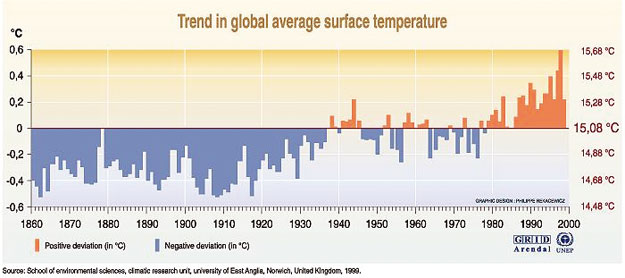
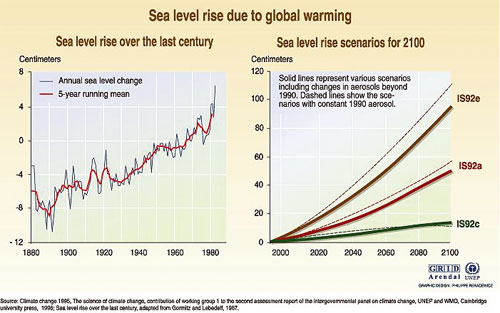
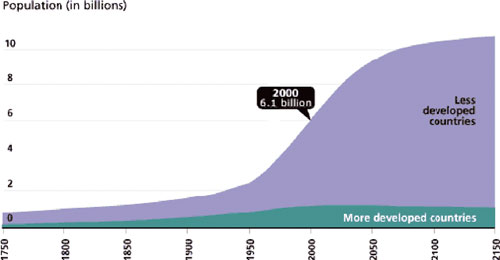
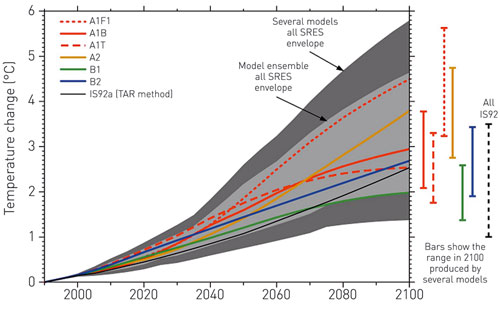
Climate models predict surface temperature rise in the next century
1.5 Global environmental governance
Humanity is already ‘managing the planet’, but in an unconnected and haphazard way driven ultimately by individual and group needs and desires. The Earth System is being pushed beyond its natural operating domain and the global management challenges involved in the achievement of a sustainable future are unprecedented.
Widespread public awareness of the ‘environment’ dates back to the 1960s and 1970s, born from concerns such as air and water pollution, use of pesticides, and disasters such as the first catastrophic oil spill from a supertanker. Many governments established environment ministries and environmental protection agencies in the 1970s, leading to new consideration of environmental issues and demands for environmental information. Industry too became more environmentally aware, with the realisation of new trends in consumer behaviour and due to the introduction of new legislation and environmental regulations.
Environmental governance is a global endeavour, however, and requires global solutions beyond the mandate of individual governments. Over the last two decades, the prospect that the global climate could change as a result of human influence has generated widespread concern. An unprecedented co-operative global response has developed as a result, including:
- international decision-making and policy measures: Governments and national and regional agencies are pursuing increased political and legal obligations to address Earth System-related topics of global concern. Such obligations are often encapsulated within international treaties, whose signatories have explicit requirements placed upon them;
- collaboration in scientific research and assessment: including the establishment of the Intergovernmental Panel on Climate Change (IPCC) in 1988 by the World Meteorological Organisation (WMO) and the UN Environment Programme (UNEP). The IPCC acts as the source of technical advice to the United Nations Framework Convention on Climate Change (UNFCCC).
There are several examples of far-sightedness on the part of governments as nations have struggled to assemble a coherent system of global environmental governance in response to increasing environmental awareness: e.g. the Montreal Protocol (on protection of the ozone layer) and the Convention on International Trade in Endangered Species (CITES). There are in fact 500 or so international environmental agreements now in effect, of which about 150 are global treaties. But environmental trend indicators suggest that our prodigious efforts at environmental diplomacy have largely failed to make serious headway against the world’s most pressing environmental challenges.
Basic principles of good global environmental decision-making were pioneered at the Rio Earth Summit in 1992, where 172 nations endorsed environmental governance principles when they signed the Rio Declaration on Environment and Development, a charter of 27 principles meant to guide the world community toward sustainable development. The World Summit on Sustainable Development (Johannesburg, 2002) reviewed the progress of the previous 10 years and initiated new commitments on: expanding access to water and sanitation, energy, improving agricultural yields, managing toxic chemicals, protecting biodiversity and improving ecosystem management - not only by governments, but also by NGOs, intergovernmental organizations and businesses, who launched over 300 voluntary initiatives. The problem in applying these good governance practices is not their novelty, but the fact that they profoundly challenge traditional government institutions and economic practices.
The challenge is further complicated politically, by the mismatch in timing between the environmental and political/electoral impact, and by the fact that only though international action – commonly agreed and commonly implemented – can the problem be addressed, since profound structural and economic re-engineering will be involved for participating nations. Disparities between developed and developing countries will emerge and nations may seek competitive advantage in the process. Such teething problems have all been apparent in the definition and implementation of treaties such as the Kyoto Protocol to the UNFCCC which imposes binding limits on greenhouse gas emissions by developed countries relative to their 1990 levels.
One of the challenges is the difficulty of agreement on specific targets, their enforcement and the financing of that enforcement. A more systemic problem is that current environmental agreements have arisen in an ad hoc and largely uncoordinated fashion as each new environmental problem – acid rain, ozone depletion, global warming – has entered the public consciousness. They reflect a single-issue approach toward environmental stewardship and have not sprung from an integrated perspective that sees the common drivers of environmental decline.
At the international level, there is rhetorical commitment to the goals of sustainable development and participatory decision-making. However, there is far less commitment to localising these goals in national policies and decision-making practices. There is a fundamental reluctance in our societies to shoulder the domestic political and financial costs to make global environmental treaties enforceable.
1.6 Global science for global sustainability
Just as science and technology has given us the evidence to measure the danger of climate change, so it can help us find safety from it. Earth System science is the key to implementing any approach towards good planetary management, providing us with the necessary insights into the feasibility, risks, trade-offs and timeliness of any strategy considered.
The nature of climate change issues presents special challenges in terms of the need for global information and data on key planetary indicators, which can provide the information required for governments and policy makers to make well-informed decisions. Recognising that no single country can satisfy all of the observational requirements that are necessary for monitoring of the Earth System, governments are taking steps to harmonise and integrate their observing networks and satellite observing systems to be able to address common problems of global concern.
This document discusses the need for observations of planet Earth and its environment and highlights the opportunities presented by Earth observation satellite systems to produce information for decision-making.
If the best current scientific expertise is correct in predicting the future impacts of human-induced climate change and the likelihood that such changes are, if anything, likely to accelerate with an expanding human population in the coming century – then such information will become increasingly vital; providing an essential foundation for the development of ethics of global governance and strategies for sustainable Earth System management that will define how humankind adapts in future to the expected global change.
BACK TO TOP
|









